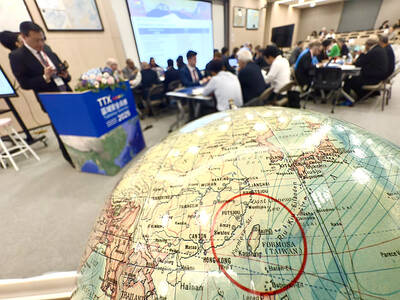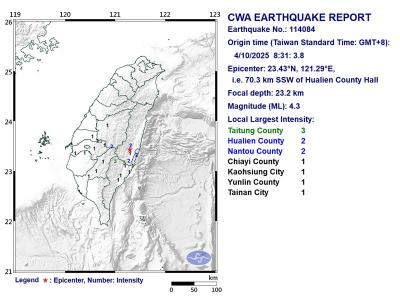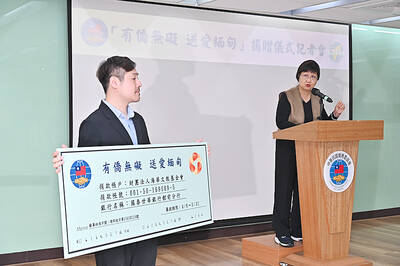In a bid to preserve the Hokkien language, educators yesterday urged the Ministry of Education to tightly regulate Hokkien textbooks for elementary and junior high schools.
"This is an important way to ensure that our students are building their Hokkien language ability on correct linguistic foundations and not on some loose and inconsistent basis," said Chu Yuan-kai (
Hokkien (河洛語), the language of the southern region of Fujian Province -- more commonly known as Min Nan Hua (閩南話) or Taiwanese -- is the first language of about 14.35 million people in Taiwan, or 67 percent of the population.
"As the Ministry of Education encourages national schools to dedicate themselves to promoting Taiwan-oriented values by teaching Hokkien in their curriculums, it is quite important to make sure that the language is being taught and learned correctly," Chu said.
According to Chu, schools offer a freestyle Hokkien curriculum, "meaning that teachers of Hokkien are free to get their teaching and classroom materials from the general market."
"However, most of the Hokkien writing publications we came across on the market nowadays use various incorrect and inconsistent styles," Chu said.
Writing of Hokkien has been distorted during this past century because of Japan's colonization and then the KMT's rule, during which the use of Hokkien was discouraged or banned, Chu said.
"The correct way to write Hokkien, which is made up of 15 consonant sounds and 30 vowel sounds, is to use Chinese characters to spell out every Hokkien syllable," Chu said.
"So using romanization or direct Chinese characters to represent the Hokkien sounds, or a combination of the English alphabet and Chinese characters are all incorrect," he said.
Chu added that all these incorrect methods of Hokkien writing have distorted the original essence of Hokkien writing.
Chu called on the Ministry of Education to canvass Hokkien linguistic specialists to compile standard classroom Hokkien materials.
"Only by ensuring students are building their Hokkien language on a correct basis will it help the government's efforts in enhancing the promotion and preservation of Taiwanese culture," Chu said.

Taiwan is stepping up plans to create self-sufficient supply chains for combat drones and increase foreign orders from the US to counter China’s numerical superiority, a defense official said on Saturday. Commenting on condition of anonymity, the official said the nation’s armed forces are in agreement with US Admiral Samuel Paparo’s assessment that Taiwan’s military must be prepared to turn the nation’s waters into a “hellscape” for the Chinese People’s Liberation Army (PLA). Paparo, the commander of the US Indo-Pacific Command, reiterated the concept during a Congressional hearing in Washington on Wednesday. He first coined the term in a security conference last

DEFENSE: The National Security Bureau promised to expand communication and intelligence cooperation with global partners and enhance its strategic analytical skills China has not only increased military exercises and “gray zone” tactics against Taiwan this year, but also continues to recruit military personnel for espionage, the National Security Bureau (NSB) said yesterday in a report to the Legislative Yuan. The bureau submitted the report ahead of NSB Director-General Tsai Ming-yen’s (蔡明彥) appearance before the Foreign and National Defense Committee today. Last year, the Chinese People’s Liberation Army (PLA) conducted “Joint Sword-2024A and B” military exercises targeting Taiwan and carried out 40 combat readiness patrols, the bureau said. In addition, Chinese military aircraft entered Taiwan’s airspace 3,070 times last year, up about

A magnitude 4.3 earthquake struck eastern Taiwan's Hualien County at 8:31am today, according to the Central Weather Administration (CWA). The epicenter of the temblor was located in Hualien County, about 70.3 kilometers south southwest of Hualien County Hall, at a depth of 23.2km, according to the administration. There were no immediate reports of damage resulting from the quake. The earthquake's intensity, which gauges the actual effect of a temblor, was highest in Taitung County, where it measured 3 on Taiwan's 7-tier intensity scale. The quake also measured an intensity of 2 in Hualien and Nantou counties, the CWA said.

The Overseas Community Affairs Council (OCAC) yesterday announced a fundraising campaign to support survivors of the magnitude 7.7 earthquake that struck Myanmar on March 28, with two prayer events scheduled in Taipei and Taichung later this week. “While initial rescue operations have concluded [in Myanmar], many survivors are now facing increasingly difficult living conditions,” OCAC Minister Hsu Chia-ching (徐佳青) told a news conference in Taipei. The fundraising campaign, which runs through May 31, is focused on supporting the reconstruction of damaged overseas compatriot schools, assisting students from Myanmar in Taiwan, and providing essential items, such as drinking water, food and medical supplies,